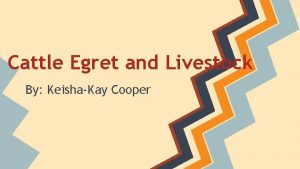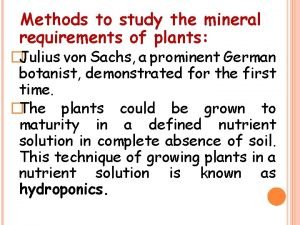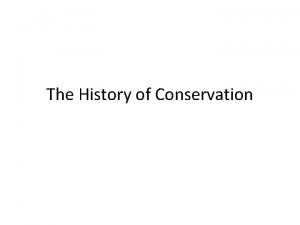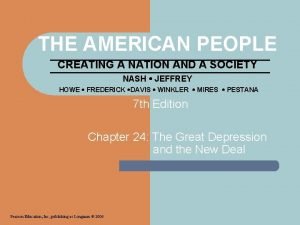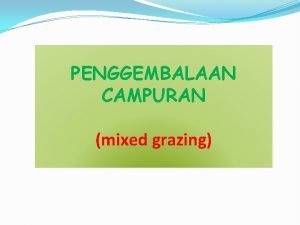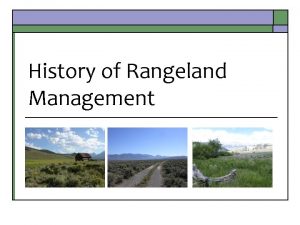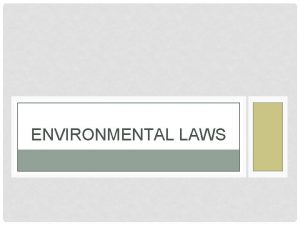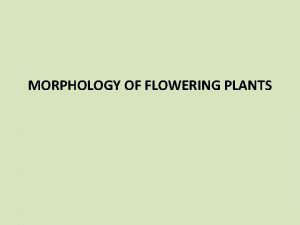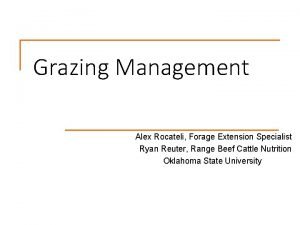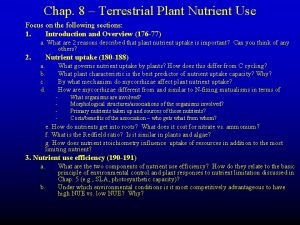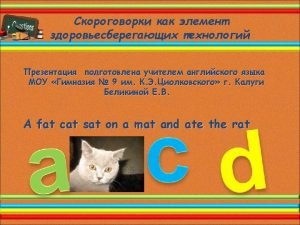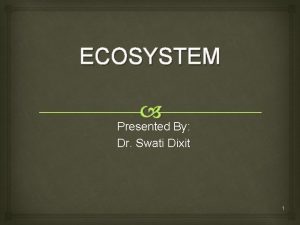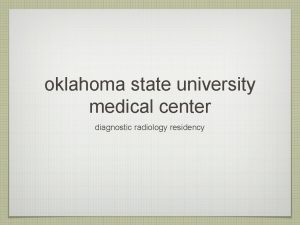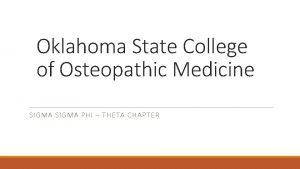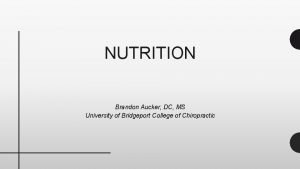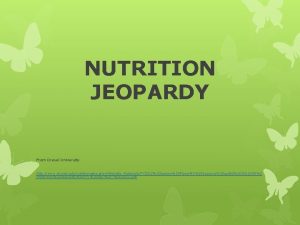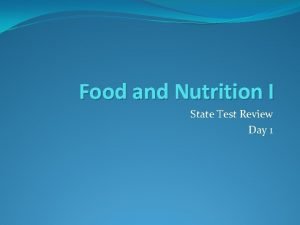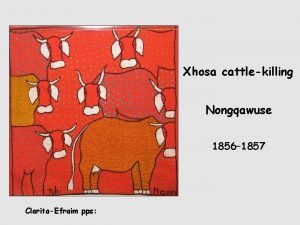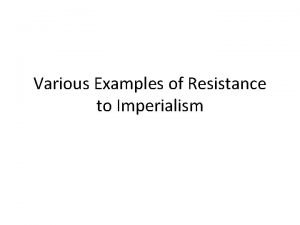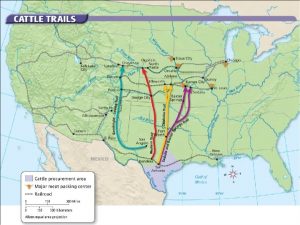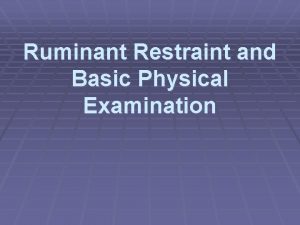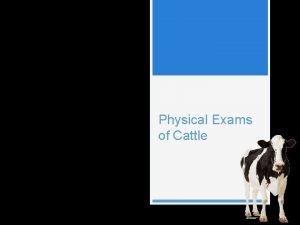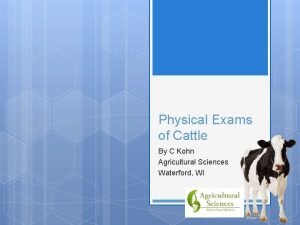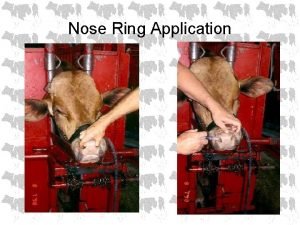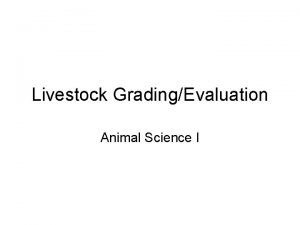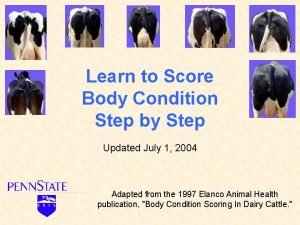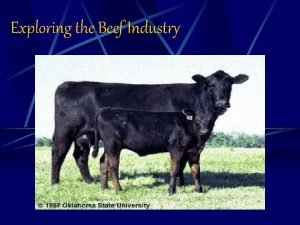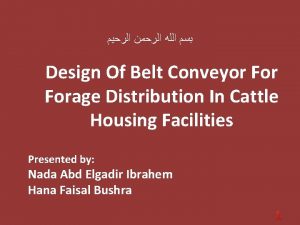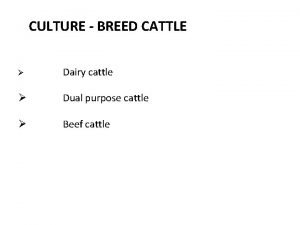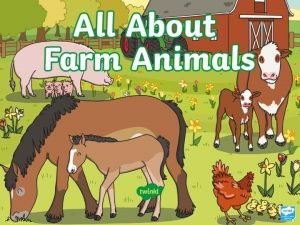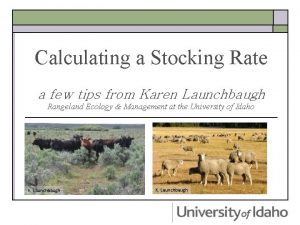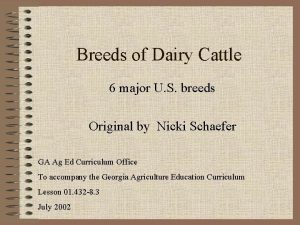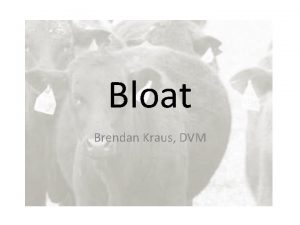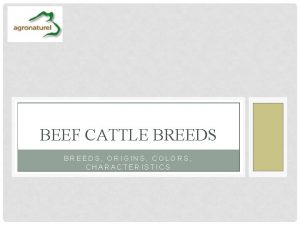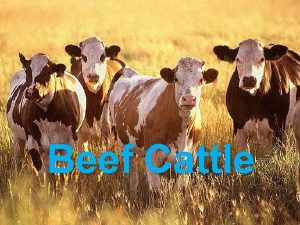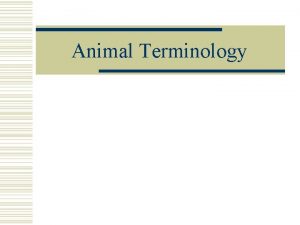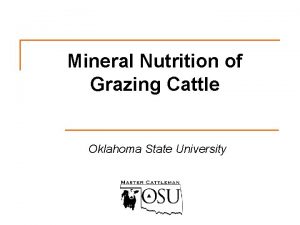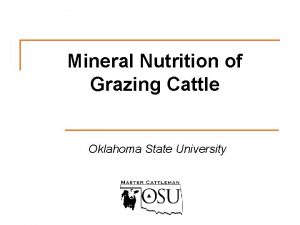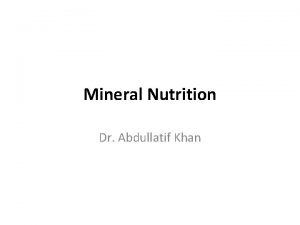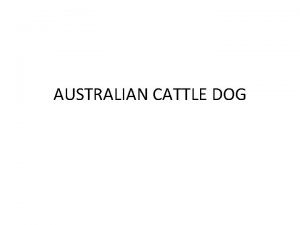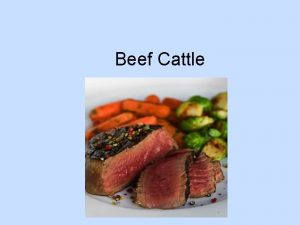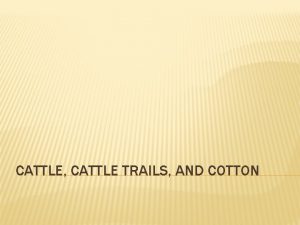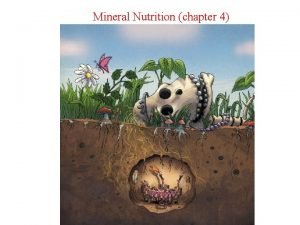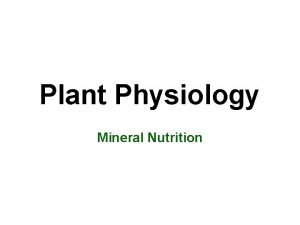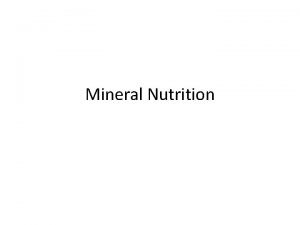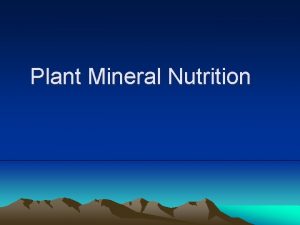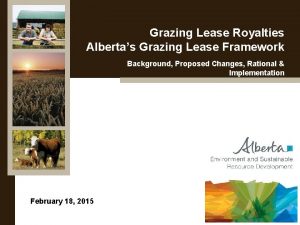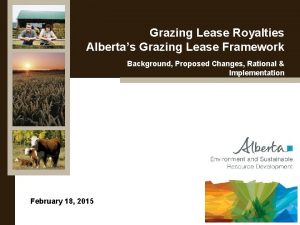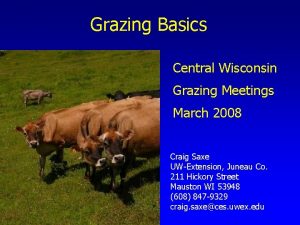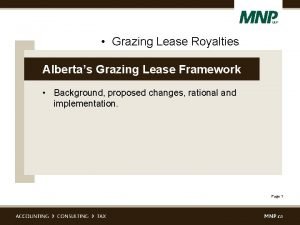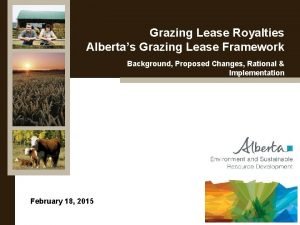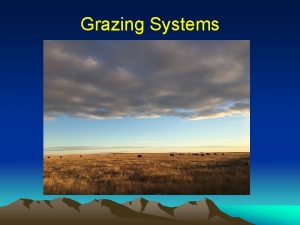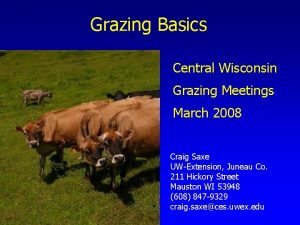Mineral Nutrition of Grazing Cattle Oklahoma State University














































- Slides: 46

Mineral Nutrition of Grazing Cattle Oklahoma State University

Lesson Outline and Objectives • Discuss typical mineral composition of common Oklahoma forages • Consider mineral needs of cattle • Determinerals that are most likely needed in a supplement

Importance? Proper mineral and vitamin nutrition contributes to: – A strong immune system – Reproductive efficiency – Weight gain

Why All the Fuss? • Producers have endless options • Annual mineral costs vary from $2 to $40 per cow: Cattle Fax • Requirements vary considerably

Why All the Fuss? …cont. • Forage mineral concentration changes over time (within a year) • Mineral interactions add to the uncertainty • Identifying site specific mineral needs and(or) deficiencies is costly and time consuming

“In matters of style, swim with the current; In matters of principle, stand like a rock” Will Rogers

Why Do We Supplement Salt and Minerals? • Forage diet may not meet the animals requirement • Offset imbalance of an antagonistic mineral that is too high in forage • Deliver vitamins, antibiotics, ionophores

Macro or Major • • • Ca P Magnesium Sulfur K - potassium Sodium Micro or Trace • • • Selenium Zinc Manganese Iron Copper Cobalt

Factors That Influence Forage Mineral Concentration • • • Forage species Plant maturity Grazing pressure (leaf vs stem) Weathering Soil mineral concentration and/or fertilizer applications

Forage Species Composition data: Oklahoma, Lusby and Selk, 1994 National, Greene et al. , 1998

Sodium Requirement

Phosphorus Requirement

Copper Requirement

Zinc Requirement

Manganese Requirement

Selenium Requirement

Iron Requirement

Species Summary • Legumes are an excellent source of minerals • Almost all forages (except legumes) are low in Na • Native warm season grasses are moderate to low in P while other grasses are moderate • All grasses contain low Cu and Zn • Fescue tends to be low in Se, while other forages are moderate to adequate

Plant Maturity

Influence of Plant Maturity on Mineral Composition Source: Greene et al. , 1987

Carotene in Native Pasture NRC Req. Waller et al. , 1972

Grazing Pressure

Influence of Grazing Pressure on Forage Minerals • Leaf has 2 X to 3 X of most minerals compared to stem • Limited forage availability (<1, 200 lb per acre) reduces dry matter intake

Nitrogen Fertilization

Effects of Late-summer N Fertilization Rate on Minerals in Bermudagrass Did not change concentrations of: Mineral Ca, % Cu, ppm Mo, ppm Mean 0. 42 3. 86 0. 43 Source: Lalman et al. , 2002 SE 0. 02 0. 14 0. 02 P>F 0. 9 0. 8 0. 6

Effects of Late-summer N Fertilization Rate on Minerals in Bermudagrass Increased concentrations of: Mineral P, % Mg, % K, % S, % Mean 0. 16 0. 10 0. 36 0. 22 *P <. 01 Source: Lalman et al. , 2002 Contrast* Lin Lin Percent 0 vs 135 17 33 36 19

Effects of Late-summer N Fertilization Rate on Minerals in Bermudagrass Decreased concentrations of: Mineral FE, ppm Zn, ppm Mean 318 21. 7 114 *P <. 01 Source: Lalman et al. , 2002 Contrast* Lin Lin Percent 0 vs 135 27 16 18

Weathering

Harvest Date: Calcium NRC Linear P <. 01 Quad P <. 01 Nov vs March = 24% Source: Lalman et al. , 2002

Harvest Date: Phosphorus NRC Linear P <. 01 Quad P <. 01 Nov vs March = 39% Source: Lalman et al. , 2002

Harvest Date: Magnesium NRC Linear P <. 01 Quad P <. 01 Nov vs March = 50% Source: Lalman et al. , 2002

Harvest Date: Potassium NRC Linear P <. 01 Quad P <. 01 Nov vs March = 76% Source: Lalman et al. , 2002

Summary: Forage Mineral Composition • Many factors influence forage mineral composition • A general idea of species differences, maturity, and weathering (standing forage) can lead to a logical supplementation plan

Mineral Supplementation

Consider the Form • Sulfates are more available than oxides: 80 to 100 VS 0 to 70 – Cu – Zn • Organic forms have higher availability compared to inorganic: 100 to 130

If It Isn’t Broke, Don’t Fix It! • Are you satisfied with fertility? – Pregnancy = 90% or more? – Weaning rate = 86% or more? • Are you satisfied with weaning weights? – Weaning weight = 525 lb or more? • Do you have evidence that your calves remain healthy (don’t get sick) after they are weaned?

Take Care of the BIG Things First • Cows calve in good body condition (nutrition) • Well planned and executed herd health program (disease control) • Maintain a fertile cow herd (cull problem cows and genetic selection)

Mineral Programs and Costs Program Cost/cow/year Salt only Salt + dicalcium phosphate Salt + dical + TM + vit. pack Salt + dical + organic TM $2. 00 $6. 00 $11. 00 $19. 00

Percentage Improvement in Calf Crop Weaned Needed to Cover Additional Costs Program Increased Weaning Rate Salt only Salt + dicalcium phosphate Salt + dical + TM + Vit. Pack Salt + dical + organic TM 0% 1% 3% 6%

Composition of OSU Range Research Center Mineral Ca, % P, % Mg, % Cost per ton Cu, ppm = $450 Zn, ppm Se, ppm Forage Quality Avg to Low High 12 10 8 6 1 8 1000 3000 12 12 Cows consume both native and bermudagrass forage

Other Additives?

Home Mixing?

Protect Your Investment


Summary • Production history and forage/feed mineral concentration are a good place to begin • Na, P, Cu, Zn are frequently deficient in Oklahoma. Se, Mn ? • Mineral supplements do not need to be extremely complicated or expensive

 Cattle egrets and livestock
Cattle egrets and livestock Mineral nutrition in plants ppt
Mineral nutrition in plants ppt Mineral nutrition in plants ppt
Mineral nutrition in plants ppt Lacey act 1900
Lacey act 1900 Taylor grazing act 1934
Taylor grazing act 1934 Continuous grazing adalah
Continuous grazing adalah Taylor grazing act 1934
Taylor grazing act 1934 Food chain food chain food chain
Food chain food chain food chain Taylor grazing act 1934
Taylor grazing act 1934 In some plants like grass monstera
In some plants like grass monstera Navajo nation grazing permit laws
Navajo nation grazing permit laws Costal plain
Costal plain Grazing food chain
Grazing food chain Three grey geese in a green field grazing figures of speech
Three grey geese in a green field grazing figures of speech Detritus food chain
Detritus food chain Grazing food chain
Grazing food chain Fadada ou
Fadada ou Oklahoma state radiology residency
Oklahoma state radiology residency Oklahoma 3rd grade math standards
Oklahoma 3rd grade math standards Oklahoma state college of osteopathic medicine
Oklahoma state college of osteopathic medicine Oklahoma state standards ela
Oklahoma state standards ela Alska state bird
Alska state bird University of bridgeport nutrition
University of bridgeport nutrition Myplate nutrition jeopardy
Myplate nutrition jeopardy Endosperm of wheat
Endosperm of wheat Ibali lika nongqawuse
Ibali lika nongqawuse Maji maji rebellion definition ap world history
Maji maji rebellion definition ap world history Texas cattle drive map
Texas cattle drive map Slidetodoc.com
Slidetodoc.com Cow physical exam
Cow physical exam Cow withers
Cow withers Osu master cattleman program
Osu master cattleman program Vagus indigestion in cattle
Vagus indigestion in cattle Frame size muscle thickness and thriftiness
Frame size muscle thickness and thriftiness Sacral fat pad
Sacral fat pad Beef cattle parts
Beef cattle parts Conveyor belt cattle feeder
Conveyor belt cattle feeder Dual purpose cattle breeds
Dual purpose cattle breeds Cattle give us
Cattle give us Calculate stocking rate
Calculate stocking rate 6 breeds of dairy cattle
6 breeds of dairy cattle Treatment for bloat in cattle
Treatment for bloat in cattle Frame score cattle
Frame score cattle Hooks and pins on cattle
Hooks and pins on cattle Beef cattle characteristics
Beef cattle characteristics Chianina blade steak
Chianina blade steak Mature male cattle
Mature male cattle
